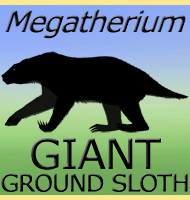


Palaeochiropteryx
Name:
Palaeochiropteryx
(Ancient hand wing).
Phonetic: Pay-lee-o-ky-rop-teh-riks.
Named By: Pierre Revilliod - 1917.
Classification: Chordata, Mammalia, Chiroptera,
Palaeochiropterygidae.
Species: P. tupaiodon
(type), P. spiegeli.
Diet: Insectivore.
Size: Wingspan between 25 and 30 centimetres
long.
Known locations: Germany, Messel Pit.
Time period: Lutetian of the Eocene.
Fossil representation: Many specimens, some almost
complete and so well preserved that they include impressions of soft
tissue, fur and even stomach contents.
Despite
the fact that fossils of Palaeochiropteryx are
dated all the way back
to the Lutetian period of the Eocene, this bat is already almost like
modern day bats are. In depth study of the cochlea of
Palaeochiropteryx has revealed that it as an
intermediate level of
development, meaning that it was not as advanced as modern
echolocating bats, but it was still substantially more developed that
the cochlea of bats that do not echolocate. When you combine this
observation with the discovery of insect remains (mostly moths and
caddis flies) within the stomach of some specimens, it is clear
that Palaeochiropteryx was capable of using
echolocation to locate prey
while on the wing.
The
types of insects found inside the stomachs of Palaeochiropteryx
are
also of types that are mostly nocturnal (mostly does not mean
exclusively, it is recognised that there are many types of daylight
flying moth, but as a whole these are in the minority). This
means that Palaeochiropteryx would probably emerge
from where they were
roosting for the day at dusk when the sun slipped beneath the horizon
and the light started to fade, because this would be when their prey
was becoming most numerous. As the night continued and total darkness
set in, Palaeochiropteryx would have no light to
see by, and this
also reinforces the theory that Palaeochiropteryx
was able to
echolocate, as this would be the only way they would be able to
detect insects like moths as they were flying about in the darkness.
The
dental formulae for Palaeochiropteryx is
2.1.3.3. for the upper jaw
and 3.1.3.3. for the lower. Each formula can be read by the
number of specific kinds of teeth in one half of the jaw only, with
the first number being incisors, second canines, third premolars
and fourth molars. So altogether the upper jaw had four canines,
two incisors, six premolars and six molars (across both sides),
while the lower jaw had six incisors, two canines, six premolars
and six molars for a combined total of thirty-eight teeth in the
mouth. The dental formula for Palaeochiropteryx
is identical to some
modern bats, which again displays how little bats have changed in
their overall form.
Palaeochiropteryx
was still not quite a modern bat, and careful observation reveals
some primitive features. Aside from the underdeveloped (but still
functional for echolocation) cochlea, Palaeochiropteryx
also
retained claws on their index fingers.
The
Messel Pit of Germany is what remains of what was once probably an
ancient caldera (the crater of a volcano). Water eventually
filled this crater to form a lake, exactly like what sometimes
happens with volcanoes today. In the Eocene this caldera was still
active, though eruptions seem to have been focused around the sudden
release of volcanic gasses, such as Carbon Dioxide and Sulphur
Dioxide. These gases would have erupted up out of the surface of the
water and spread into the surrounding (at the time) tropical
forests suffocating any animals that were living close to the ground.
This would include low flying bats like Palaeochiropteryx
that may
have been suffocated by a sudden release of volcanic gases as they were
flying low for insects. Losing consciousness from lack of oxygen they
would have tumbled into the lake where they would have drowned and sunk
to the bottom. This would explain why many seemingly healthy adult
bats with full stomachs died, and also why they were so well
preserved, since the low oxygen content of the water would have
reduced the amounts of bacterium and scavenging animals capable of
destroying the body before it was buried in sediment.
Further reading
- Evolution of nocturnality in bats: Potential competitors and
predators during their early history, J. Rydell & J.
R. Speakman - 1995.
- The evolution of flight and echolocation in pre-bats: an
evaluation of the energetics of reach hunting, John R. Speakman
- 1999.
- Messel Pit Fossil site, Evelies Mayer - 2007.
----------------------------------------------------------------------------
Random favourites
 |
 |
 |
 |




